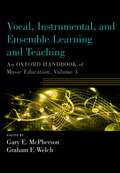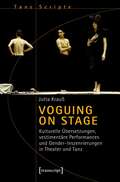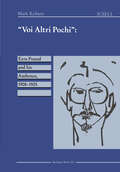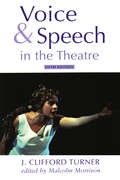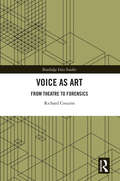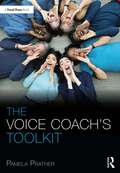- Table View
- List View
The Vocal Arts Workbook: A Practical Course for Developing the Expressive Actor’s Voice (RADA Guides)
by David Carey Rebecca Clark Carey"Refreshing and imaginative, this book teaches through enhanced awareness and instructs through clear and specific exercises." Cicely BerryA practical course for actors and other professional voice-users to achieve clarity and expressivity with the voice. Setting out the fundamental principles of voice training, the book provides structured and informed methods for developing vocal power, range and flexibility. At the heart of the book are practical projects with exercises and examples supplied in the accompanying online videos, which enable you to:- connect your breath with your voice- meet the demands of your performance- use your voice expressively through fully controlling pitch and range Each chapter consists of an introductory framework; explorations; exercises; follow-up work; suggested texts and further reading altogether offering a unique, student-centred approach not found in other voice books.This revised edition speaks more directly to the actor, rather than the voice teacher, through revised terminology and descriptions, updated references, additional appendices on health and other issues related to trends in contemporary drama and questions of equality, diversity and inclusion with respect to vocabulary and suggested texts. Includes forewords by Cicely Berry and Fiona Shaw.
The Vocal Arts Workbook: A Practical Course for Developing the Expressive Actor’s Voice (RADA Guides)
by David Carey Rebecca Clark Carey"Refreshing and imaginative, this book teaches through enhanced awareness and instructs through clear and specific exercises." Cicely BerryA practical course for actors and other professional voice-users to achieve clarity and expressivity with the voice. Setting out the fundamental principles of voice training, the book provides structured and informed methods for developing vocal power, range and flexibility. At the heart of the book are practical projects with exercises and examples supplied in the accompanying online videos, which enable you to:- connect your breath with your voice- meet the demands of your performance- use your voice expressively through fully controlling pitch and range Each chapter consists of an introductory framework; explorations; exercises; follow-up work; suggested texts and further reading altogether offering a unique, student-centred approach not found in other voice books.This revised edition speaks more directly to the actor, rather than the voice teacher, through revised terminology and descriptions, updated references, additional appendices on health and other issues related to trends in contemporary drama and questions of equality, diversity and inclusion with respect to vocabulary and suggested texts. Includes forewords by Cicely Berry and Fiona Shaw.
Vocal, Instrumental, and Ensemble Learning and Teaching: An Oxford Handbook of Music Education, Volume 3 (Oxford Handbooks)
by Gary E. McPherson and Graham F. WelchVocal, Instrumental, and Ensemble Learning and Teaching is one of five paperback books derived from the foundational two-volume Oxford Handbook of Music Education. Designed for music teachers, students, and scholars of music education, as well as educational administrators and policy makers, this third volume in the set emphasizes the types of active musical attributes that are acquired when learning an instrument or to sing, together with how these skills can be used when engaging musically with others. These chapters shed light on how the field of voice instruction has changed dramatically in recent decades and how physiological, acoustical, biomechanical, neuromuscular, and psychological evidence is helping musicians and educators question traditional practices. The authors discuss research on instrumental learning, demonstrating that there is no 'ideal' way to learn, but rather that a chosen learning approach must be appropriate for the context and desired aims. This volume rounds out with a focus on a wide range of perspectives dealing with group performance of instrumental music, an area that is organized and taught in many varied ways internationally. Contributors Alfredo Bautista, Robert Burke, James L. Byo, Jean Callaghan, Don D. Coffman, Andrea Creech, Jane W. Davidson, Steven M. Demorest, Robert A. Duke, Robert Edwin, Shirlee Emmons, Sam Evans, Helena Gaunt, Susan Hallam, Lee Higgins, Jere T. Humphreys, Harald Jers, Harald Jørgensen, Margaret Kartomi, Reinhard Kopiez , William R. Lee, Andreas C. Lehmann, Gary E. McPherson, Steven J. Morrison, John Nix, Ioulia Papageorgi, Kenneth H. Phillips, Lisa Popeil, John W. Richmond, Carlos Xavier Rodriguez, Nelson Roy, Robert T. Sataloff, Frederick A. Seddon, Sten Ternström, Michael Webb, Graham F. Welch, Jenevora Williams, Michael D. Worthy
Vocal, Instrumental, and Ensemble Learning and Teaching: An Oxford Handbook of Music Education, Volume 3 (Oxford Handbooks)
Vocal, Instrumental, and Ensemble Learning and Teaching is one of five paperback books derived from the foundational two-volume Oxford Handbook of Music Education. Designed for music teachers, students, and scholars of music education, as well as educational administrators and policy makers, this third volume in the set emphasizes the types of active musical attributes that are acquired when learning an instrument or to sing, together with how these skills can be used when engaging musically with others. These chapters shed light on how the field of voice instruction has changed dramatically in recent decades and how physiological, acoustical, biomechanical, neuromuscular, and psychological evidence is helping musicians and educators question traditional practices. The authors discuss research on instrumental learning, demonstrating that there is no 'ideal' way to learn, but rather that a chosen learning approach must be appropriate for the context and desired aims. This volume rounds out with a focus on a wide range of perspectives dealing with group performance of instrumental music, an area that is organized and taught in many varied ways internationally. Contributors Alfredo Bautista, Robert Burke, James L. Byo, Jean Callaghan, Don D. Coffman, Andrea Creech, Jane W. Davidson, Steven M. Demorest, Robert A. Duke, Robert Edwin, Shirlee Emmons, Sam Evans, Helena Gaunt, Susan Hallam, Lee Higgins, Jere T. Humphreys, Harald Jers, Harald Jørgensen, Margaret Kartomi, Reinhard Kopiez , William R. Lee, Andreas C. Lehmann, Gary E. McPherson, Steven J. Morrison, John Nix, Ioulia Papageorgi, Kenneth H. Phillips, Lisa Popeil, John W. Richmond, Carlos Xavier Rodriguez, Nelson Roy, Robert T. Sataloff, Frederick A. Seddon, Sten Ternström, Michael Webb, Graham F. Welch, Jenevora Williams, Michael D. Worthy
Vocal Projections: Voices in Documentary
by Annabelle Honess Roe Maria PramaggioreVocal Projections: Voices in Documentary examines a previously neglected topic in the field of documentary studies: the political, aesthetic, and affective functions that voices assume. On topics ranging from the celebrity voice over to ventriloquism, from rockumentary screams to feminist vocal politics, these essays demonstrate myriad ways in which voices make documentary meaning beyond their expository, evidentiary and authenticating functions.The international range of contributors offers an innovative approach to the issues relating to voices in documentary. While taking account of the existing paradigm in documentary studies pioneered by Bill Nichols, in which voice is equated with political rhetoric and subjective representation, the contributors move into new territory, addressing current and emerging research in voice, sound, music and posthumanist studies.
Vocal Projections: Voices in Documentary
by Annabelle Honess Roe Maria PramaggioreVocal Projections: Voices in Documentary examines a previously neglected topic in the field of documentary studies: the political, aesthetic, and affective functions that voices assume. On topics ranging from the celebrity voice over to ventriloquism, from rockumentary screams to feminist vocal politics, these essays demonstrate myriad ways in which voices make documentary meaning beyond their expository, evidentiary and authenticating functions.The international range of contributors offers an innovative approach to the issues relating to voices in documentary. While taking account of the existing paradigm in documentary studies pioneered by Bill Nichols, in which voice is equated with political rhetoric and subjective representation, the contributors move into new territory, addressing current and emerging research in voice, sound, music and posthumanist studies.
VOCUS: A Visual Attention System for Object Detection and Goal-Directed Search (Lecture Notes in Computer Science #3899)
by Simone FrintropThis monograph presents a complete computational system for visual attention and object detection. VOCUS (Visual Object detection with a Computational attention System) represents a major step forward on integrating data-driven and model-driven information into a single framework. Additionally, the volume contains an extensive review of the literature on visual attention, detailed evaluations of VOCUS in different settings, and applications of the system.
Vogue The Shoe (Vogue)
by The Conde Nast Publications Ltd Harriet QuickShoes fascinate women of all ages and have the power to crystallize a moment in fashion. In Vogue: The Shoe, Harriet Quick has curated more than 300 fabulous images from a century of British Vogue, featuring remarkable styles that range from the humble clog to exquisite hand-embroidered haute couture stilettoes via fetishistic cuissardes and outrageous statement heels. The images are grouped into five thematic chapters devoted to dazzling Cinderella heels; Town & Country classics; Cult Style inspiration; the escapism of Summer Dreaming and the extreme heels of Fetish & Fantasia. The images include pivotal work from Hoyningen-Huene, Irving Penn, Corinne Day, Norman Parkinson and Nick Knight. Vogue: The Shoe is the latest title in the prestigious Vogue portfolio series, which launched in autumn 2014 with Vogue: The Gown, followed by Vogue: The Jewellery in autumn 2015.
Voguing on Stage - Kulturelle Übersetzungen, vestimentäre Performances und Gender-Inszenierungen in Theater und Tanz (TanzScripte #57)
by Jutta KraußVoguing-Performances haben Eingang in Tanzinszenierungen gefunden. Dabei entstehen Choreografien, die Voguing und den Ballroom als praktischen und theoretischen Referenzrahmen nutzen und fortschreiben. Jutta Krauß eröffnet mit ihrer Studie eine Diskursarena, in welcher diese Transformationsprozesse betrachtet werden. Ausgehend von einer umfassenden Archiv-Arbeit und der Untersuchung maßgeblicher Choreografien - von Georgina Philp, Gerard Reyes, Trajal Harrell, Knut Klaßen und Monika Gintersdorfer - entwirft sie Anschauungsmodelle und Ästhetikkonzepte unter den Gesichtspunkten der kulturellen Übertragung, vestimentären Performance und Gender-Inszenierung. Dabei zeigt sich in der Vielfalt an Voguing-Performances auf Theaterbühnen das Voguing-Archiv in Bewegung.
“Voi Altri Pochi”: Ezra Pound and his Audience, 1908–1925 (International Cooper Series in English Language and Literature)
by Mark KyburzCritical tradition has established a certain way of reading Ezra Pound, one that places the meanings of the words on the page at the centre of interest and neglects poetic communication. The present study contributes to the recent challenge to this critical orthodoxy, which has led to his canonization as a "difficult" poet, by investigating the pragmatic dimension of Pound's work. In its effort to reconstruct the dynamic communicative interface between Pound and his audiences in the early period of his career (1908-1925), this study draws on relevance theory, a recent sharpening in pragmatic theory, not so much to produce a "new" reading of his poetry, but to suggest how Pound became difficult: it is argued that the relative success and failure of his poetry to enhance cognitive and civic renewal depended on the dialectic between his presumptions of audience and the interpretive expectations and skills of his actual historical readers.
Voice: Onstage And Off
by Robert Barton Rocco dal VeraVoice: Onstage and Off is a comprehensive guide to the process of building, mastering, and fine-tuning the voice for performance. Every aspect of vocal work is covered, from the initial speech impulse and the creation of sound, right through to refining the final product in different types of performance. This highly adaptable course of study empowers performers of all levels to combine and evolve their onstage and offstage voices.
Voice: Onstage and Off
by Robert Barton Rocco Dal VeraVoice: Onstage and Off is a comprehensive guide to the process of building, mastering, and fine-tuning the voice for performance. Every aspect of vocal work is covered, from the initial speech impulse and the creation of sound, right through to refining the final product in different types of performance. This highly adaptable course of study empowers performers of all levels to combine and evolve their onstage and offstage voices.
Voice (Readings in Theatre Practice)
by Jane BostonThis wide-ranging volume explores the technical and physical aspects of voice as a craft, questioning its definitions, its historical presence, training practices and its publications. Drawing on a wealth of experience, Jane Boston presents a selection of readings that demonstrate and contextualize some of the defining moments of voice throughout history. This clear and accessible text examines the relationship between voice and aesthetics and poetics, against the backdrop of class, race and gender politics, demonstrating how vocal training has been and still is inevitably connected to such issues. Underpinned by theory, voice practitioner accounts, and cultural and historical contextualization, this comprehensive resource will be invaluable for practitioners, researchers and students of voice studies, physical theatre and theatre history.
Voice (Readings in Theatre Practice)
by Jane BostonThis wide-ranging volume explores the technical and physical aspects of voice as a craft, questioning its definitions, its historical presence, training practices and its publications. Drawing on a wealth of experience, Jane Boston presents a selection of readings that demonstrate and contextualize some of the defining moments of voice throughout history. This clear and accessible text examines the relationship between voice and aesthetics and poetics, against the backdrop of class, race and gender politics, demonstrating how vocal training has been and still is inevitably connected to such issues.Underpinned by theory, voice practitioner accounts, and cultural and historical contextualization, this comprehensive resource will be invaluable for practitioners, researchers and students of voice studies, physical theatre and theatre history.
Voice Acting For Dummies
by David Ciccarelli Stephanie CiccarelliMake a career out of your voice? Easy. Voice acting is like acting, but just using your voice! It's a unique career where the actor's voice can be heard worldwide-in commercials, on audiobooks, in animated movies, documentaries, online videos, telephone systems and much, much more. The point is to bring the written word to life with the human voice. With step-by-step explanations and an abundance of examples, Voice Acting For Dummies is the ultimate reference for budding voice actors on auditioning, recording, producing voice-overs, and promoting themselves as a voice actor. Creating a voice acting demo Finding your signature voice Interpreting scripts Using audio editing software Promoting your voice acting talents If you're an aspiring voice actor or an actor or singer considering a career transition, Voice Acting For Dummies has everything you need to let your voice talents soar.
Voice Acting For Dummies
by David Ciccarelli Stephanie CiccarelliMake a career out of your voice? Easy. Voice acting is like acting, but just using your voice! It's a unique career where the actor's voice can be heard worldwide-in commercials, on audiobooks, in animated movies, documentaries, online videos, telephone systems and much, much more. The point is to bring the written word to life with the human voice. With step-by-step explanations and an abundance of examples, Voice Acting For Dummies is the ultimate reference for budding voice actors on auditioning, recording, producing voice-overs, and promoting themselves as a voice actor. Creating a voice acting demo Finding your signature voice Interpreting scripts Using audio editing software Promoting your voice acting talents If you're an aspiring voice actor or an actor or singer considering a career transition, Voice Acting For Dummies has everything you need to let your voice talents soar.
Voice And The Actor
by Cicely BerryVoice and the Actor is the first classic work by Cicely Berry, Voice Director of the Royal Shakespeare Company and world-famous voice teacher. Encapsulating her renowned method of teaching voice production, the exercises in this straightforward, no-nonsense guide will develop relaxation, breathing and muscular control - without which no actor or speaker can achieve their full potential. Illustrated with passages used in Cicely Berry's own teaching, Voice and the Actor is the essential first step towards speaking a text with truth and meaning. Inspiring and practical, her words will be a revelation for beginner and professional alike.
Voice and New Writing, 1997-2007: Articulating the Demos
by M. InchleyIn New Labour's empathetic regime, how did diverse voices scrutinize its etiquettes of articulation and audibility? Using the voice as cultural evidence, Voice and New Writing explores what it means to 'have' a voice in mainstream theatre and for newly included voices to negotiate with the institutions that 'find' and 'represent' their identities.
Voice and Speech in the Theatre
by J. Clifford Turner Malcolm MorrisonThis is a classic book on voice and speech, designed for actors at all levels. One of the great voice teachers of his day, J. Clifford Turner here uses simple and direct language to impart the necessary technical 'basics' of speech and voice.
Voice and Speech in the Theatre
by J. Clifford Turner Malcolm MorrisonThis is a classic book on voice and speech, designed for actors at all levels. One of the great voice teachers of his day, J. Clifford Turner here uses simple and direct language to impart the necessary technical 'basics' of speech and voice.
Voice and the Young Actor: A workbook and DVD (Performance Books #1)
by Rena Cook"Many high school theatre teachers do not have access to intensive voice instruction. Rena's book will fill that void. It is instructive, concise, easy to understand, and most importantly for the high school student, fun. High school teachers will find the book an invaluable voice and acting resource. It would be beneficial to all high school theatre programs to have Voice and the Young Actor as a textbook." Kim Moore, High School Teacher, ColoradoThere are thousands of students enrolled in school drama classes in yet very often young actors cannot be heard, are culturally encouraged to trail off at the ends of sentences, and habitually use only the lowest pitches of the voice. Drama teachers, frequently ask, "How can I get my students to speak up, to be clear, to articulate?" Voice and the Young Actor is written for the school actor, is inviting in format, language and illustration and offers clear and inspiring instructions. A DVD features 85 mins and 28 filmed voice workshop exercises with the author and two students. These students log their reflections in the book on what they have learned throughout their training and there is space for the reader to do the same. A workbook in format, Voice and the Young Actor provides simple, interactive vocal exercises and shows young performers how to take voice work into acting.
Voice as Art: From Theatre to Forensics (Routledge Voice Studies)
by Richard CouzinsVoice as Art considers how artists have used human voices since they became reproducible and entered art discourse in the twentieth century. The discussion embeds artworks using voices within historical and theoretical contexts in a comparative overview arguing that reproduction caused increased creativity moving from acting to creating phonic materials framed by phenomenological deep listening by early video and performance to the plurality and sampling of postmodernism and the multiple angles of contemporary forensic listening. This change is an example of how artistic practice reveals the ideologies of listening. Using a range of examples from Hugo Ball, Martha Rosler, Vito Acconci, Bruce Nauman, Janet Cardiff and Mike Kelley through to contemporary practice by Shilpa Gupta, The Otolith Group and Elizabeth Price, the voice is tracked through modernism and postmodernism to posthumanism in relation to speaking subjects, sculptural objects, documents, dramaturgical utterance, forensic evidence, verbatim techniques and embodied listening. This book gives artists, researchers and art audiences ways to understand how voices exist in between theoretical discourses, and how with their utterances, artists create new dispositions in space by reworking genres to critique cultural form and meaning. This book will be of great interest to students and practitioners of sound art, visual culture and theatre and performance.
Voice as Art: From Theatre to Forensics (Routledge Voice Studies)
by Richard CouzinsVoice as Art considers how artists have used human voices since they became reproducible and entered art discourse in the twentieth century. The discussion embeds artworks using voices within historical and theoretical contexts in a comparative overview arguing that reproduction caused increased creativity moving from acting to creating phonic materials framed by phenomenological deep listening by early video and performance to the plurality and sampling of postmodernism and the multiple angles of contemporary forensic listening. This change is an example of how artistic practice reveals the ideologies of listening. Using a range of examples from Hugo Ball, Martha Rosler, Vito Acconci, Bruce Nauman, Janet Cardiff and Mike Kelley through to contemporary practice by Shilpa Gupta, The Otolith Group and Elizabeth Price, the voice is tracked through modernism and postmodernism to posthumanism in relation to speaking subjects, sculptural objects, documents, dramaturgical utterance, forensic evidence, verbatim techniques and embodied listening. This book gives artists, researchers and art audiences ways to understand how voices exist in between theoretical discourses, and how with their utterances, artists create new dispositions in space by reworking genres to critique cultural form and meaning. This book will be of great interest to students and practitioners of sound art, visual culture and theatre and performance.
The Voice Coach's Toolkit (The Focal Press Toolkit Series)
by Pamela PratherThe Voice Coach's Toolkit identifies the primary professional vocal coaching opportunities and the avenues by which a student or early career coach can navigate the vocation. For purposes of this book, the Voice Coach is defined as someone who coaches the spoken voice in three precise areas: the teaching artist, the professional film/TV/theatre coach, and the professional voice-user coach. These three coaching worlds are broadly defined and each area includes in-depth interviews and practical advice from top coaches along with the author’s personal expertise. The book can be read in sections or as a whole, making it as useful for early career coaches as it is for those looking to expand their vocal coaching career or vocal pedagogy students who need a broad survey of all three areas.
The Voice Coach's Toolkit (The Focal Press Toolkit Series)
by Pamela PratherThe Voice Coach's Toolkit identifies the primary professional vocal coaching opportunities and the avenues by which a student or early career coach can navigate the vocation. For purposes of this book, the Voice Coach is defined as someone who coaches the spoken voice in three precise areas: the teaching artist, the professional film/TV/theatre coach, and the professional voice-user coach. These three coaching worlds are broadly defined and each area includes in-depth interviews and practical advice from top coaches along with the author’s personal expertise. The book can be read in sections or as a whole, making it as useful for early career coaches as it is for those looking to expand their vocal coaching career or vocal pedagogy students who need a broad survey of all three areas.

